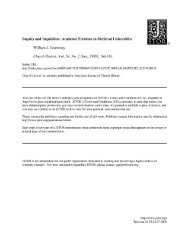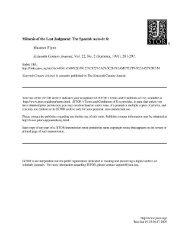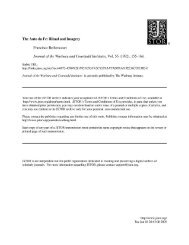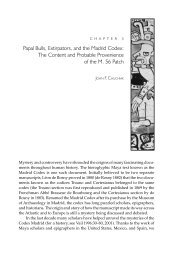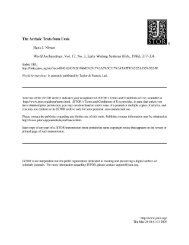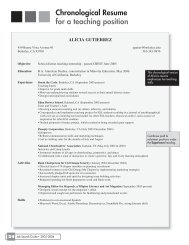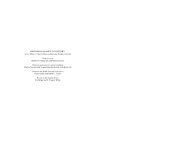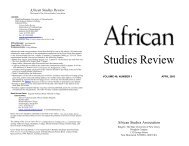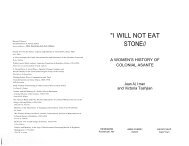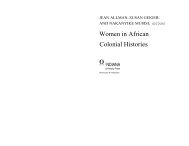An Archaic Recording System in the Uruk-Jemdet Nasr Period ...
An Archaic Recording System in the Uruk-Jemdet Nasr Period ...
An Archaic Recording System in the Uruk-Jemdet Nasr Period ...
You also want an ePaper? Increase the reach of your titles
YUMPU automatically turns print PDFs into web optimized ePapers that Google loves.
<strong>An</strong> <strong>Archaic</strong> <strong>Record<strong>in</strong>g</strong> <strong>System</strong> <strong>in</strong> <strong>the</strong> <strong>Uruk</strong>-<strong>Jemdet</strong> <strong>Nasr</strong> <strong>Period</strong><br />
Denise Schmandt-Besserat<br />
American Journal of Archaeology, Vol. 83, No. 1. (Jan., 1979), pp. 19-48.<br />
Stable URL:<br />
http://l<strong>in</strong>ks.jstor.org/sici?sici=0002-9114%28197901%2983%3A1%3C19%3AAARSIT%3E2.0.CO%3B2-2<br />
American Journal of Archaeology is currently published by Archaeological Institute of America.<br />
Your use of <strong>the</strong> JSTOR archive <strong>in</strong>dicates your acceptance of JSTOR's Terms and Conditions of Use, available at<br />
http://www.jstor.org/about/terms.html. JSTOR's Terms and Conditions of Use provides, <strong>in</strong> part, that unless you have obta<strong>in</strong>ed<br />
prior permission, you may not download an entire issue of a journal or multiple copies of articles, and you may use content <strong>in</strong><br />
<strong>the</strong> JSTOR archive only for your personal, non-commercial use.<br />
Please contact <strong>the</strong> publisher regard<strong>in</strong>g any fur<strong>the</strong>r use of this work. Publisher contact <strong>in</strong>formation may be obta<strong>in</strong>ed at<br />
http://www.jstor.org/journals/aia.html.<br />
Each copy of any part of a JSTOR transmission must conta<strong>in</strong> <strong>the</strong> same copyright notice that appears on <strong>the</strong> screen or pr<strong>in</strong>ted<br />
page of such transmission.<br />
The JSTOR Archive is a trusted digital repository provid<strong>in</strong>g for long-term preservation and access to lead<strong>in</strong>g academic<br />
journals and scholarly literature from around <strong>the</strong> world. The Archive is supported by libraries, scholarly societies, publishers,<br />
and foundations. It is an <strong>in</strong>itiative of JSTOR, a not-for-profit organization with a mission to help <strong>the</strong> scholarly community take<br />
advantage of advances <strong>in</strong> technology. For more <strong>in</strong>formation regard<strong>in</strong>g JSTOR, please contact support@jstor.org.<br />
http://www.jstor.org<br />
Wed Aug 15 13:30:51 2007
<strong>An</strong> <strong>Archaic</strong> <strong>Record<strong>in</strong>g</strong> <strong>System</strong><br />
<strong>in</strong> <strong>the</strong> <strong>Uruk</strong>-<strong>Jemdet</strong> <strong>Nasr</strong> period*<br />
Abstract<br />
In <strong>the</strong> ancient Middle East (n<strong>in</strong>th-second millennia<br />
B.C.), reckon<strong>in</strong>g was practiced with <strong>the</strong> help of<br />
clay tokens <strong>in</strong> geometric and odd shapes which<br />
stood for numbers and various commodities. This<br />
paper presents an assemblage of 661 tokens dat<strong>in</strong>g<br />
from <strong>the</strong> end of <strong>the</strong> fourth millennium B.C. (<strong>Uruk</strong>-<br />
<strong>Jemdet</strong> <strong>Nasr</strong> period) which are classified <strong>in</strong>to 15<br />
ma<strong>in</strong> types with some zoo subtypes. Charts illustrate<br />
<strong>the</strong> occurrence of each type <strong>in</strong> major sites of Iran,<br />
Iraq and Syria. The paper discusses <strong>the</strong> series of<br />
major <strong>in</strong>novations which characterize <strong>the</strong> evolution<br />
of <strong>the</strong> token system at <strong>the</strong> end of <strong>the</strong> fourth mil-<br />
lennium B.C. and <strong>in</strong> particular:<br />
I. <strong>An</strong> improvement <strong>in</strong> <strong>the</strong> manufacture of <strong>the</strong><br />
tokens.<br />
2. <strong>An</strong> <strong>in</strong>crease <strong>in</strong> <strong>the</strong> repertory of shapes of tokens<br />
<strong>in</strong>clud<strong>in</strong>g <strong>the</strong> appearance of naturalistic types<br />
such as animal heads, vessels and utensils.<br />
3. A proliferation of mark<strong>in</strong>gs on <strong>the</strong> surface of<br />
<strong>the</strong> tokens: <strong>in</strong>cised l<strong>in</strong>es (55% of <strong>the</strong> tokens),<br />
punched mark<strong>in</strong>gs (4%) and applique pellets<br />
or coils.<br />
4. The appearance of perforations on 30% of <strong>the</strong><br />
tokens, suggest<strong>in</strong>g <strong>the</strong> str<strong>in</strong>g<strong>in</strong>g of tokens for<br />
special transactions.<br />
5. The storage of tokens <strong>in</strong> archives by means of<br />
sealed envelopes (bullae) sometimes provided<br />
with exterior mark<strong>in</strong>gs which correspond with<br />
<strong>the</strong> shape and number of tokens <strong>in</strong>cluded <strong>in</strong>side.<br />
The various <strong>in</strong>novations <strong>in</strong> <strong>the</strong> archaic record<strong>in</strong>g<br />
system around 3100 B.C. are viewed as a response<br />
*This paper was orig<strong>in</strong>ally presented at <strong>the</strong> 79th General<br />
Meet<strong>in</strong>g of <strong>the</strong> Archaeological Institute of America, on December<br />
18, 1977, <strong>in</strong> Atlanta. This paper was made possible<br />
by a travel grant by <strong>the</strong> Research Institute and <strong>the</strong> Center for<br />
Middle Eastern Studies at <strong>the</strong> University of Texas at Aust<strong>in</strong>.<br />
I am <strong>in</strong>debted to M.W. Green, Freie Universitat, Berl<strong>in</strong>, Project<br />
Archaische Texte aus <strong>Uruk</strong>, for mak<strong>in</strong>g available her provisional<br />
list of archaic signs of <strong>Uruk</strong> and for her <strong>in</strong>valuable help<br />
<strong>in</strong> sett<strong>in</strong>g up <strong>the</strong> chart of parallels between tokens and <strong>Uruk</strong><br />
pictographs. I am also grateful for her advice on <strong>the</strong> manuscript.<br />
I would also like to thank W.W. Hallo, Yale Univer-<br />
sity, who has been k<strong>in</strong>d enough to give his time and thoughts<br />
to <strong>the</strong> problems presented here. His comments have been very<br />
important <strong>in</strong> <strong>the</strong> completion of <strong>the</strong> paper. The objects dis-<br />
DENISE SCHMANDT-BESSERAT<br />
to <strong>the</strong> pressure of economic developments such as<br />
<strong>the</strong> expansion of crafts production <strong>in</strong> workshops,<br />
<strong>the</strong> <strong>in</strong>crease <strong>in</strong> local and long distance trade and <strong>the</strong><br />
emergence of bureaucracy <strong>in</strong> <strong>the</strong> new city states. The<br />
first written tablets which appear about 3100 B.C.<br />
are presented as <strong>the</strong> ultimate result of <strong>the</strong> evolution<br />
of <strong>the</strong> token system; it is suggested that writ<strong>in</strong>g<br />
derives from <strong>the</strong> system of mark<strong>in</strong>gs used on <strong>the</strong><br />
bullae. A series of charts stresses <strong>the</strong> similarity be-<br />
tween pictographs and tokens, which leads to <strong>the</strong><br />
conclusion that <strong>the</strong> first signs of Sumerian writ<strong>in</strong>g<br />
represented numbers and commodities accord<strong>in</strong>g to<br />
<strong>the</strong> shape of <strong>the</strong> tokens used <strong>in</strong> <strong>the</strong> archaic record<strong>in</strong>g<br />
system.<br />
Research <strong>in</strong> <strong>the</strong> past thirty years has <strong>in</strong>dicated<br />
<strong>the</strong> existence .<strong>in</strong> <strong>the</strong> ancient Middle East of a re-<br />
cord<strong>in</strong>g system based on tokens. A. Leo Oppen-<br />
heim <strong>in</strong> 1958 first noted <strong>the</strong> use of "counters" or<br />
tokens (Akkadian: abnu, pl. abnu, abnati) at <strong>the</strong><br />
Palace of Nuzi <strong>in</strong> <strong>the</strong> second millennium B.C.'<br />
At that time writ<strong>in</strong>g was well developed but a<br />
system of tokens was used to compute and keep<br />
records, for example of <strong>the</strong> number of animals<br />
kept <strong>in</strong> <strong>the</strong> herds of <strong>the</strong> <strong>in</strong>stitution. Pierre Amiet<br />
recognized <strong>the</strong> same system of record<strong>in</strong>g at Susa<br />
<strong>in</strong> <strong>the</strong> fourth millennium B.C., <strong>the</strong>refore extend<strong>in</strong>g<br />
it back <strong>in</strong> time by two thousand years, to a period<br />
ei<strong>the</strong>r contemporary or slightly preced<strong>in</strong>g <strong>the</strong> ap-<br />
pearance of writ<strong>in</strong>g.' The tokens at Susa were<br />
made of clay and were modelled <strong>in</strong> a variety of<br />
cussed are mostly unpublished. I would like to give special<br />
thanks to P. Amiet at <strong>the</strong> Musee du Louvre, Paris; Dr. K.<br />
Deller at <strong>the</strong> Orientalisches Sem<strong>in</strong>ar, University of Heidelberg;<br />
G. van Driel at <strong>the</strong> Assyriological Institute, Leiden; Mahmoud<br />
M. Heretani at <strong>the</strong> Aleppo Museum, Aleppo; Dr. Liane Jakob-<br />
Rost at <strong>the</strong> Vorderasiatisches Museum, East Berl<strong>in</strong>; Dr. E.<br />
Sollberger at <strong>the</strong> British Museum, London and Dr. Eva Strom-<br />
menger at <strong>the</strong> Staatlichen Museen. Berl<strong>in</strong>, for generously giv<strong>in</strong>g<br />
me access to <strong>the</strong> collections of Susa, <strong>Uruk</strong>, Ubaid, Habuba<br />
Kabira and Jebel Aruda.<br />
A.L. Oppenheim, "<strong>An</strong> Operational Device <strong>in</strong> Mesopotamian<br />
Bureaucracy," INES 18 (~ygy) 121-28.<br />
2 P. Amiet, Glyptiqrre Szr.rienne (MCmoires de la delegation<br />
archiologique en Iran 43, Paris 1972) I 69-70, I1 pl. 61-88.
shapes which Amiet assumed stood for various<br />
commodities. S<strong>in</strong>ce 1969, my research on <strong>the</strong> early<br />
uses of clay has enabled me to document <strong>the</strong> oc-<br />
currence of such tokens <strong>in</strong> quantity <strong>in</strong> practically<br />
all Middle Eastern sites start<strong>in</strong>g <strong>in</strong> <strong>the</strong> n<strong>in</strong>th mil-<br />
lennium B.C.3 It is presumed that <strong>the</strong> tokens were<br />
used for computation and record-keep<strong>in</strong>g <strong>in</strong> house-<br />
holds and bus<strong>in</strong>esses. Certa<strong>in</strong> tokens seem to have<br />
had a numerical value; for example, a small cone<br />
stood for one and a large cone for sixty. O<strong>the</strong>rs,<br />
as po<strong>in</strong>ted out by Amiet, stood for commodities: a<br />
sheep was probably represented by a disc with an<br />
<strong>in</strong>cised cross.<br />
The purpose of this paper is to document <strong>the</strong><br />
token system at <strong>the</strong> time of <strong>the</strong> appearance of<br />
writ<strong>in</strong>g <strong>in</strong> <strong>the</strong> late <strong>Uruk</strong> and <strong>Jemdet</strong> <strong>Nasr</strong> period,<br />
ca. 3100-2900 B.C. I propose to: (I) describe<br />
<strong>the</strong> various shapes of tokens known from this pe-<br />
riod; (2) document <strong>the</strong> graphic mark<strong>in</strong>gs on <strong>the</strong><br />
tokens; (3) po<strong>in</strong>t out <strong>the</strong> similarity of token<br />
shapes to Sumerian pictographs; (4) trace <strong>the</strong> con-<br />
nection between tokens and writ<strong>in</strong>g; and (5) provide<br />
a catalogue of tokens <strong>in</strong> <strong>the</strong> form of synoptic<br />
charts (Appendix I).<br />
THE TOKEN SYSTEhf<br />
The study is based on 661 tokens from Iraq, Iran<br />
3 D. Schmandt-Besserat, "<strong>An</strong> <strong>Archaic</strong> <strong>Record<strong>in</strong>g</strong> <strong>System</strong> and<br />
<strong>the</strong> Orig<strong>in</strong> of Writ<strong>in</strong>g," Syro-12.ie.iopotamian Studies I, 2 (July<br />
1977) 1-32; also "The Earliest Precursor of Writ<strong>in</strong>g," Scientific<br />
American 238, 6 (1978) 50-59. In <strong>the</strong>se articles I suggest<br />
that writ<strong>in</strong>g may not have been a sudden <strong>in</strong>vention, as previ-<br />
ously assumed, but may represent a new step <strong>in</strong> <strong>the</strong> evolution<br />
of a system of record<strong>in</strong>g which was <strong>in</strong>digenous to <strong>the</strong> Middle<br />
East s<strong>in</strong>ce <strong>the</strong> n<strong>in</strong>th millennium B.C.<br />
4The study is based on <strong>the</strong> thirty-four tokens from <strong>Uruk</strong><br />
stored at <strong>the</strong> Orientalisches Sem<strong>in</strong>ar <strong>in</strong> Heidelberg, Germany<br />
and additional samples published <strong>in</strong> Charles Jordan, Vorlarrfger<br />
Bericht uber die von der Notgeme<strong>in</strong>schaft der derrtschen Wis-<br />
senschaft <strong>in</strong> <strong>Uruk</strong> Warka unternommenen Ausgrabrrngen (UVB)<br />
2 (1931) 47 fig. 41; and also A. Noldeke and E. He<strong>in</strong>rich,<br />
UVB I4 (1933) pl. 14; UVB 21 (1965) 3I PIS. 17-19. DOCU-<br />
mentation on <strong>the</strong> 425 tokens <strong>in</strong> <strong>the</strong> Staatlichen Museen was<br />
k<strong>in</strong>dly provided by Dr. L. Jakob-Rost; unfortunately, <strong>the</strong> <strong>in</strong>for-<br />
mation arrived too late to be <strong>in</strong>cluded <strong>in</strong> this article.<br />
E. Mackay, "Report on Excavations at <strong>Jemdet</strong> <strong>Nasr</strong>, Iraq,"<br />
Field Museum of Natrrral History <strong>An</strong>thropology Memoirs I<br />
(1931) 277-78, pls. 71 and 74. Accord<strong>in</strong>g to <strong>the</strong> site report,<br />
<strong>Jemdet</strong> <strong>Nasr</strong> produced "a considerable number" of tokens, <strong>in</strong><br />
particular <strong>in</strong> <strong>the</strong> shapes of cones and ovoids. Unfortunately,<br />
I had to limit myself to <strong>the</strong> 9 examples for which precise<br />
documentation is provided <strong>in</strong> <strong>the</strong> report.<br />
H. de Genouillac, "Fouilles de Telloh," Epoqzres pre'sargo-<br />
niqtres (Paris 1934) 58-60 and 63, pls. 35, 37 and 43. There<br />
are <strong>in</strong> reality many more tokens from Tello than <strong>the</strong> 33 <strong>in</strong>-<br />
cluded. The report draws attention only to <strong>the</strong> specimens with<br />
DENISE SCHMANDT-BESSERAT [AJA 83<br />
and Syria. One hundred and n<strong>in</strong>eteen come from<br />
Sumerian cities, particularly from <strong>Uruk</strong>4 (63<br />
tokens), <strong>Jemdet</strong> <strong>Nasr</strong>5 (g), Tello6 (36), Fara7 (10)<br />
and Ubaid8 (I). Four hundred and eighty-one<br />
tokens come from Elam, mostly from Susa"432)<br />
and Chogha Mish" (49). Lastly, <strong>the</strong> 61 specimens<br />
from two Syrian sites, Habuba Kabira" (54) and<br />
Jebel Aruda" (7), are of considerable <strong>in</strong>terest s<strong>in</strong>ce<br />
<strong>the</strong> sites may have been Sumerian outposts along<br />
<strong>the</strong> Euphrates. It is remarkable that no tokens have<br />
been found at Chagar Hazar and Tell Brak.<br />
Manufacture. The tokens are as a rule made of<br />
clay. In <strong>the</strong> <strong>Uruk</strong>-<strong>Jemdet</strong> <strong>Nasr</strong> period <strong>the</strong>y were<br />
manufactured with much greater care than <strong>in</strong> <strong>the</strong><br />
preced<strong>in</strong>g Chalcolithic and Neolithic periods. The<br />
clay chosen is very f<strong>in</strong>e and was obviously levi-<br />
gated to remove all <strong>in</strong>clusions. The clay appears<br />
to have been modelled while very wet, as a self-slip<br />
often has formed on <strong>the</strong> surface and <strong>the</strong> f<strong>in</strong>ger-<br />
pr<strong>in</strong>ts of <strong>the</strong> maker are frequently visible. The<br />
various shapes are carefully formed, <strong>the</strong> surfaces<br />
are smooth, <strong>the</strong> edges are straight and have sharp<br />
contours. One is often tempted to th<strong>in</strong>k that <strong>the</strong>y<br />
were mold made, but <strong>the</strong> lack of standardization<br />
of size suggests that <strong>the</strong>y were modelled by hand.<br />
The tokens are consistently fired throughout <strong>the</strong>ir<br />
mark<strong>in</strong>gs; while mention<strong>in</strong>g that among <strong>the</strong> la<strong>in</strong> ones ". . . il<br />
se rencontre des rondelles, pastilles, billes et cones," it does<br />
not give an idea of <strong>the</strong>ir numbers or sizes.<br />
7 E. He<strong>in</strong>rich, Fara Ergebnisse der Azcsgrabungen der deutsch-<br />
en Orient-Gesellschaft <strong>in</strong> Fara r<strong>in</strong>d Abu Hatab rgoz/oj (Berl<strong>in</strong><br />
1931) PIS. 34h7 35P.<br />
8 H.R. Hall and C.L. Woolley, Ur Excavations, I: A1 'Ubazd<br />
(Oxford 1927) 41 fig. 4. The token is presently kept at <strong>the</strong><br />
British Museum.<br />
QR. de Mecquenem and V. Scheil, Mhoires de la Mission<br />
a~che'ologique de Perse 25 (Paris 1934) 192-93 fig. 28; and<br />
R. de Mecquenem, MPmoires de la Mission arche'ologiqtre en<br />
Iran 29, Mission de Susiane (Paris 1943) 27-29, fig. 23.<br />
H.J. Kantor and P. Delougaz, "New Light on <strong>the</strong> Emer-<br />
gence of Civilization <strong>in</strong> <strong>the</strong> Near East," The UNESCO Courier<br />
(November 1969) 22-28. The <strong>in</strong>formation on <strong>the</strong> tokens from<br />
Chogha Mish was generously provided by Dr. Helene Kantor.<br />
They do not represent <strong>the</strong> totality of <strong>the</strong> f<strong>in</strong>d<strong>in</strong>gs but ra<strong>the</strong>r <strong>the</strong><br />
repertory of shapes at <strong>the</strong> site. The number of specimens for<br />
each shape will be available <strong>in</strong> <strong>the</strong> forthcom<strong>in</strong>g site report.<br />
l1 Prelim<strong>in</strong>ary reports on <strong>the</strong> site have been published by<br />
E. Strommenger <strong>in</strong> AfO 23 (1972) 131, and 24 (1973) 168-<br />
71; MDOG IOI (1969) 54-64, 102 (1970) 45-51, and 103<br />
(1971) 21-34. The tokens from Habuba Kabira presented <strong>in</strong><br />
this study <strong>in</strong>clude only those stored at <strong>the</strong> Aleppo Museum.<br />
The rema<strong>in</strong>der of <strong>the</strong> collection is <strong>in</strong> Berl<strong>in</strong>.<br />
I2A summary of <strong>the</strong> excavations is published by S.E. van<br />
der Leeuw <strong>in</strong> <strong>An</strong>tiqriitPs de I'Euphrate (Damascus 1974) 79-82.
19791 AN ARCHAIC RECORDING SYSTEM 2 1<br />
thickness. Their color ranges from whitish buff to<br />
p<strong>in</strong>k and red, with gray and black probably due<br />
to smoke dur<strong>in</strong>g fir<strong>in</strong>g. Some tokens are also made<br />
of stone, and all <strong>the</strong> examples described <strong>in</strong> <strong>the</strong><br />
<strong>Jemdet</strong> <strong>Nasr</strong> report are made of ei<strong>the</strong>r white or<br />
p<strong>in</strong>k limestone, slate, or brown sandstone.13 The<br />
size of <strong>the</strong> token is usually about 1.5-3 cm., with<br />
some specimens as small as 0.6 cm. or as large as<br />
4 cm. The great similarity <strong>in</strong> <strong>the</strong> appearance of<br />
all <strong>the</strong> objects, with regard to <strong>the</strong> quality of <strong>the</strong><br />
material, surface treatment, color, etc., suggests that<br />
<strong>the</strong>y were manufactured by skilled artisans <strong>in</strong> a<br />
pottery workshop.<br />
Shupes. The 661 tokens can be divided <strong>in</strong>to 15<br />
shapes (see charts <strong>in</strong> Appendix I) : I. spheres; 11.<br />
discs; 111. cones; IV. tetrahedra; V. biconoids; VI.<br />
ovoids; VII. cyl<strong>in</strong>ders; VIII. bent coils; IX. tri-<br />
angles or crescents; X. parabolae; XI. rectangles;<br />
XII. rhomboids; XIII. conta<strong>in</strong>ers; XIV. animals;<br />
XV. miscellaneous. It is noteworthy that most of<br />
<strong>the</strong>se shapes are of simple geometric character and<br />
can be termed abstract representations of <strong>the</strong> com-<br />
modities represented. Only <strong>the</strong> conta<strong>in</strong>ers and ani-<br />
mals are represented realistically. Each of <strong>the</strong> types<br />
may aga<strong>in</strong> be divided <strong>in</strong>to various subtypes accord<strong>in</strong>g<br />
to: (I) <strong>the</strong> size of <strong>the</strong> objects; (2) various<br />
mark<strong>in</strong>gs produced <strong>in</strong> <strong>in</strong>cised, impressed, or applique<br />
technique. I believe that all of <strong>the</strong>se varia-<br />
tions conferred a special mean<strong>in</strong>g to <strong>the</strong> objects.<br />
Types.<br />
I. Pla<strong>in</strong> tokens. Two hundred and seventy-two<br />
tokens are pla<strong>in</strong> and do not bear mark<strong>in</strong>gs of any<br />
k<strong>in</strong>d. They represent 41.14% of <strong>the</strong> objects considered<br />
<strong>in</strong> <strong>the</strong> paper.<br />
2. Incised tokens (pl. I, fig. I). As many as 362,<br />
or 54.77%, of <strong>the</strong> tokens bear <strong>in</strong>cised mark<strong>in</strong>gs.<br />
The <strong>in</strong>cisions are mostly deep grooves made with<br />
a po<strong>in</strong>ted stick or stylus. Th<strong>in</strong> <strong>in</strong>cisions executed<br />
with a very f<strong>in</strong>e po<strong>in</strong>t are rarer. On flat objects,<br />
such as discs, triangles, crescents, rectangles and<br />
parabolae, <strong>the</strong> <strong>in</strong>cisions are made on one face of<br />
<strong>the</strong> object only. On globular shapes, such as spheres,<br />
cones, ovoids and cyl<strong>in</strong>ders, <strong>the</strong> <strong>in</strong>cisions run<br />
around <strong>the</strong> entire object and are visible from all<br />
sides. The mark<strong>in</strong>gs are placed on <strong>the</strong> most conspicuous<br />
part of <strong>the</strong> object with <strong>the</strong> concern for<br />
13 Mackay (supra n. 5) 277-78.<br />
symmetry typical of Sumerian and Elamite art of<br />
<strong>the</strong> period.<br />
The patterns mostly consist of parallel l<strong>in</strong>es or<br />
short strokes and, less frequently, nicks. O<strong>the</strong>r<br />
l<strong>in</strong>ear patterns <strong>in</strong>clude pla<strong>in</strong> crosses, St. <strong>An</strong>drew's<br />
crosses, checkers and crisscrosses. The number of<br />
l<strong>in</strong>es, strokes and nicks does not seem random<br />
and, although all numbers of mark<strong>in</strong>gs from I to<br />
10 are represented, s<strong>in</strong>gle, double, triple and j<br />
mark<strong>in</strong>gs occur with conspicuous frequency. It is<br />
noteworthy that, except for 2, uneven numbers of<br />
<strong>in</strong>cisions are more frequently used. All types of<br />
tokens except conta<strong>in</strong>ers and animals <strong>in</strong>clude speci-<br />
mens bear<strong>in</strong>g a s<strong>in</strong>gle <strong>in</strong>cised l<strong>in</strong>e: 134 tokens (37%<br />
of all <strong>in</strong>cised specimens) bear one <strong>in</strong>cision. Typi-<br />
cally, <strong>the</strong> <strong>in</strong>cision is placed <strong>in</strong> <strong>the</strong> center of <strong>the</strong> ob-<br />
ject divid<strong>in</strong>g <strong>the</strong> surface <strong>in</strong>to two equal parts; for<br />
<strong>in</strong>stance, <strong>the</strong> discs are divided <strong>in</strong>to two semi-circles,<br />
<strong>the</strong> biconoids <strong>in</strong>to two cones. In o<strong>the</strong>r cases <strong>the</strong><br />
<strong>in</strong>cision follows a conspicuous l<strong>in</strong>e of <strong>the</strong> object,<br />
for <strong>in</strong>stance, <strong>the</strong> maximum diameter of <strong>the</strong> ovoids.<br />
Forty-four objects bear 3 <strong>in</strong>cisions and 27 bear j.<br />
As a rule, <strong>the</strong> median l<strong>in</strong>e occupies <strong>the</strong> center of<br />
<strong>the</strong> object and <strong>the</strong> o<strong>the</strong>rs are equidistant on ei<strong>the</strong>r<br />
side. Patterns of 3 and j parallel l<strong>in</strong>es mostly occur<br />
on triangles and parabolae. Seven and g parallel<br />
l<strong>in</strong>es occur on one specimen respectively.<br />
Among <strong>the</strong> even numbers of mark<strong>in</strong>gs, 2 occurs<br />
with <strong>the</strong> greatest frequency, on 28 objects. The<br />
two l<strong>in</strong>es are drawn at equal distance from <strong>the</strong> cen-<br />
ter of <strong>the</strong> objects. The two-l<strong>in</strong>e pattern is mostly<br />
found on spheres, 314 spheres and triangles. Groups<br />
of 4, 6 and 10 occur respectively 4 and j times and<br />
<strong>the</strong>re is a s<strong>in</strong>gle example with 16 strokes.<br />
Simple patterns, such as perpendicular l<strong>in</strong>es meet-<br />
<strong>in</strong>g <strong>in</strong> a cross, occur on 8 discs as well as on a<br />
sphere, an ovoid, a rectangle and a vessel. The St.<br />
<strong>An</strong>drew's cross is rare and occurs only on one<br />
cone, one ovoid and one of <strong>the</strong> miscellaneous<br />
shapes.<br />
Crisscross and checker patterns as well as series<br />
of multiple l<strong>in</strong>es are found on 56 examples, <strong>in</strong>-<br />
clud<strong>in</strong>g bent coils, spheres, cones, ovoids, triangles<br />
and <strong>the</strong> edges of discs. Of <strong>the</strong> more complex mark-<br />
<strong>in</strong>gs <strong>the</strong> ladder pattern occurs on four examples<br />
among which are two rectangles, one cyl<strong>in</strong>der and<br />
one parabola. It is <strong>in</strong>terest<strong>in</strong>g to note that <strong>the</strong><br />
stylized representation of an ear of wheat as a k<strong>in</strong>d
22 DENISE SCHMANDT-BESSERAT [AJA 83<br />
of herr<strong>in</strong>gbone pattern, which is <strong>the</strong> sign for cereal<br />
on <strong>the</strong> <strong>Uruk</strong> tablets, occurs on a rectangle (Appendix<br />
I, Type XI, 4) and on an ovoid (Appendix<br />
I, Type VI, 3d). The sign which later means "excellent"<br />
(a star) is rendered plastically by a starshaped<br />
disc (Appendix I, Type 11, II~) and is<br />
<strong>in</strong>cised on <strong>the</strong> face of a second disc (Appendix 11,<br />
Type 11, ~ob). Only a few of <strong>the</strong> various patterns<br />
give <strong>the</strong> impression of be<strong>in</strong>g decorative; <strong>the</strong>y <strong>in</strong>clude<br />
a cone decorated with hang<strong>in</strong>g triangles with<br />
a central dot (Appendix I, Type 111, gf) and a<br />
cyl<strong>in</strong>der with a concentration of l<strong>in</strong>es and dots<br />
(Appendix I, Type VII, 3e).<br />
3. Tokens with circular impressions (pl. I, fig.<br />
2). There are only 24 tokens bear<strong>in</strong>g circular punch<br />
marks (3.64%). These marks are found randomly<br />
among <strong>the</strong> various types of tokens <strong>in</strong>clud<strong>in</strong>g<br />
spheres, discs, cones, tetrahedra, rhomboids, rectangles,<br />
parabolae, conta<strong>in</strong>ers and animals. As a rule,<br />
<strong>the</strong> marks appear on one side of <strong>the</strong> object only<br />
and are ei<strong>the</strong>r shallow, produced with <strong>the</strong> blunt<br />
end of a stick, or deep f<strong>in</strong>e marks possibly executed<br />
with a metal p<strong>in</strong>. The repertory of punch marks<br />
is somewhat different from <strong>the</strong> <strong>in</strong>cised l<strong>in</strong>es. Ten<br />
tokens (41.6% of <strong>the</strong> total of <strong>the</strong> impressed tokens)<br />
bear a s<strong>in</strong>gle punch, usually placed at <strong>the</strong> center<br />
of <strong>the</strong> object. N<strong>in</strong>e specimens have 6 punch marks<br />
ei<strong>the</strong>r <strong>in</strong> a straight l<strong>in</strong>e or placed <strong>in</strong> two parallel<br />
rows of three; 3 objects bear 3 circular marks arranged<br />
<strong>in</strong> a triangle formation; groups of 8, 10,<br />
16 and 22 punch marks each occur <strong>in</strong> one s<strong>in</strong>gle<br />
<strong>in</strong>stance. In conclusion, one mark<strong>in</strong>g occurs with<br />
<strong>the</strong> greatest frequency <strong>in</strong> both <strong>the</strong> <strong>in</strong>cised and<br />
punched variety. Groups of six are preferred among<br />
<strong>the</strong> punch marks. While 16 mark<strong>in</strong>gs are represented<br />
once <strong>in</strong> both types, 12 strik<strong>in</strong>gly never occur.<br />
Some specimens bear both <strong>in</strong>cised l<strong>in</strong>es and<br />
punch marks.<br />
4. Tokens with appliqut mark<strong>in</strong>gs. Three tokens<br />
have appliqut mark<strong>in</strong>gs <strong>in</strong> <strong>the</strong> form of clay pellets<br />
or coils. One of <strong>the</strong> ovoids and one of <strong>the</strong> miscellaneous<br />
shapes bear appliquC pellets, while one<br />
cyl<strong>in</strong>der is wrapped with a coil at both extremities<br />
and a third coil <strong>in</strong> <strong>the</strong> center.<br />
5. Tokens with perforations (pl. I, fig. 3). One<br />
l4Schmandt-Besserat 1977 (supra n. 3) 5-17, chart 6. A<br />
prelim<strong>in</strong>ary report of excavations at <strong>the</strong> site is published by<br />
R.J. Braidwood, R. Howe, and C. Reed, "The Iranian Prehistoric<br />
Project," Science 123 (1961) 20118-10.<br />
l5Prelim<strong>in</strong>ary reports of excavations at <strong>the</strong> site are pub-<br />
hundred and n<strong>in</strong>ety-eight (30%) have a small per-<br />
foration through <strong>the</strong>ir thickness. The perforated<br />
specimens are found among <strong>the</strong> 15 types of tokens<br />
and among pla<strong>in</strong>, <strong>in</strong>cised and punched subtypes.<br />
In o<strong>the</strong>r words, most subtypes of tokens seem<strong>in</strong>gly<br />
occur both <strong>in</strong> a perforated and an unperforated<br />
form. This should <strong>in</strong>dicate that <strong>the</strong>re were two<br />
ways of handl<strong>in</strong>g <strong>the</strong>m: by simple manipulation or<br />
by str<strong>in</strong>g<strong>in</strong>g. Several explanations come to m<strong>in</strong>d:<br />
first, <strong>the</strong> tokens could be worn as amulets around<br />
<strong>the</strong> neck or <strong>the</strong> wrist; second, <strong>the</strong> tokens could be<br />
mounted <strong>in</strong> <strong>the</strong> fashion of a present-day abacus<br />
with rows of counters held <strong>in</strong> parallel rows on<br />
pliable rods. A last possibility, suggested by Amiet<br />
<strong>in</strong> conversation, is that tokens represent<strong>in</strong>g a spe-<br />
cial transaction might have been strung toge<strong>the</strong>r.<br />
In this case one might assume that <strong>the</strong> ends of <strong>the</strong><br />
str<strong>in</strong>g would have been held by one of <strong>the</strong> elon-<br />
gated complete bullae bear<strong>in</strong>g seals for au<strong>the</strong>ntica-<br />
tion. This last hypo<strong>the</strong>sis is supported by <strong>the</strong> fact<br />
that <strong>the</strong> perforation was small and could allow only<br />
a small str<strong>in</strong>g to pass through. More important, I<br />
have not noticed any wear around <strong>the</strong> perforations<br />
I have checked, which suggests a s<strong>in</strong>gle use or<br />
little handl<strong>in</strong>g, as would occur if a str<strong>in</strong>g of tokens<br />
were kept <strong>in</strong> <strong>the</strong> archives.<br />
THE PROLIFERATION OF SHAPES<br />
The token system is remarkable for <strong>the</strong> persist-<br />
ence of <strong>the</strong> basic shapes of <strong>the</strong> tokens through <strong>the</strong><br />
millennia. The prototypes for at least ten types<br />
<strong>in</strong>clud<strong>in</strong>g spheres, discs, cones, ovoids, bent coils,<br />
cyl<strong>in</strong>ders, triangles, rectangles and animals are<br />
already present with little or no difference <strong>in</strong> <strong>the</strong><br />
token assemblage of Tepe Asiab <strong>in</strong> <strong>the</strong> n<strong>in</strong>th mil-<br />
lennium B.C.14 and tetrahedra are also present <strong>in</strong><br />
<strong>the</strong> n<strong>in</strong>th millennium B.C. at Ganj Dareh Tepe."<br />
The biconoids occur <strong>in</strong> <strong>the</strong> late Ubaid period at<br />
Djaffarabad.lVarabolae (pl. I, fig. 4), rhomboids<br />
and conta<strong>in</strong>ers are, <strong>the</strong>refore, <strong>the</strong> only types which<br />
can be identified as new <strong>in</strong> this period. One should,<br />
however, notice <strong>the</strong> proliferation of graphic mark-<br />
<strong>in</strong>gs start<strong>in</strong>g <strong>in</strong> <strong>the</strong> late <strong>Uruk</strong> period. If <strong>in</strong>cisions<br />
and punctations were known as early as <strong>the</strong> first<br />
tokens <strong>in</strong> <strong>the</strong> n<strong>in</strong>th millennium KC., <strong>the</strong>y were<br />
lished by P.E.L. Smith <strong>in</strong> "Survey of Excavations," Iran 5<br />
(1967) 138-39: 6 (1968) 158-60; 8 (1970) 178-80; 111 (1072)<br />
165-68.<br />
I"G. Dollfus, "Les Fouillez i Djaffarabad de 1969-71,"<br />
Cahir~sde la DPle'gation ArchCologiq~tr en Iran I (1971) 53-55,
19791 AN ARCHAIC RECORDING SYSTEM 23<br />
used spar<strong>in</strong>gly: one groove, one or two nicks, or a<br />
s<strong>in</strong>gle punctation. Some tokens of <strong>the</strong> Ubaid<br />
period from Djaffarabad17 and Susa have preserved<br />
traces of pa<strong>in</strong>ted patterns <strong>in</strong>clud<strong>in</strong>g parallel<br />
l<strong>in</strong>es and dots. The extraord<strong>in</strong>ary diversity of mark-<br />
<strong>in</strong>gs seems new to <strong>the</strong> late <strong>Uruk</strong> period, and <strong>the</strong>re<br />
is an apparent shift of <strong>in</strong>terest from <strong>the</strong> shape of<br />
<strong>the</strong> tokens to <strong>the</strong> mark<strong>in</strong>gs <strong>the</strong>y bear. The 661<br />
tokens of this study reach a number of 200 subtypes.<br />
The proliferation of mark<strong>in</strong>gs may suggest<br />
that more pressure was exerted at this time on <strong>the</strong><br />
system to become more precise or to <strong>in</strong>crease its<br />
repertory to handle a greater number of concepts.<br />
It is, on <strong>the</strong> o<strong>the</strong>r hand, noteworthy that <strong>the</strong>re is no<br />
report of any <strong>in</strong>cision on <strong>the</strong> specimens from <strong>the</strong><br />
site of <strong>Jemdet</strong> <strong>Nasr</strong>.<br />
DEVELOPhfENT OF THE TOKEN SYSTEXI<br />
The avchaeological context. At Susa, R. de Mec-<br />
quenem reported <strong>the</strong> f<strong>in</strong>d<strong>in</strong>g of a considerable<br />
number of tokens at a depth between 17.50 and<br />
21 m.18 He <strong>in</strong>dicates that <strong>the</strong>y belong to children's<br />
tombs and <strong>in</strong>terprets <strong>the</strong>m as devices to teach<br />
words to children (like a modern picture book).<br />
Although tokens are not <strong>in</strong>congruous among a<br />
child's funerary goods, <strong>the</strong>y certa<strong>in</strong>ly were not<br />
restricted to this use. Indeed, some were found<br />
more recently <strong>in</strong> level 18 <strong>in</strong> private build<strong>in</strong>gs, en-<br />
closed <strong>in</strong> clay envelopes (bullae). L. le Breton dates<br />
<strong>the</strong> tokens to <strong>the</strong> Susa Ca period. This is <strong>the</strong> level<br />
<strong>in</strong> which proto-Elamite writ<strong>in</strong>g appears and <strong>the</strong>se<br />
earliest tablets bear unique impressed signs.'!'<br />
In <strong>Jemdet</strong> <strong>Nasr</strong> <strong>the</strong>re is no precise <strong>in</strong>dication of<br />
context, and E. Mackay mentions that <strong>the</strong> tokens<br />
were found "all over <strong>the</strong> site.""He identifies <strong>the</strong>m<br />
as gamesmen and thus concludes that <strong>the</strong> <strong>in</strong>habi-<br />
tants of <strong>the</strong> site were a good natured and playful<br />
people. For Tello <strong>the</strong>re is no fur<strong>the</strong>r reference to<br />
<strong>the</strong>ir context than <strong>the</strong> depth at which <strong>the</strong> tokens<br />
were found, which ranges from <strong>the</strong> surface to<br />
7 m. Genouillac <strong>in</strong>terprets <strong>the</strong>m as amulets. "Ces<br />
petits riens de terre cuite trahissent le m6me souci<br />
clue la gravure des cachets et des cyl<strong>in</strong>dres, le dtsir<br />
d'avoir une marque personnelle. . . .""<br />
l7 Supra n. 16.<br />
Mccquenern and Scheil (supra n. 11) vol. 25, 192; vol.<br />
20, 21) ti& 23.<br />
I!' L. le Hrcton, "The Early Periotl at Susa: Mesopotamian<br />
Relati(~ns," Iraq 19 (1957) 112 fig. 33.<br />
'O Mackay (supra n. 5) 277.<br />
At <strong>Uruk</strong> <strong>the</strong> tokens were not found <strong>in</strong> a good<br />
stratigraphic context. Jordan reports that dur<strong>in</strong>g<br />
<strong>the</strong> 1929/1930 season a great number were found<br />
<strong>in</strong> rubble outside <strong>the</strong> walls of <strong>the</strong> Red Temple,"<br />
and suggests <strong>the</strong>ir possible use <strong>in</strong> a cult of still un-<br />
known nature. Dur<strong>in</strong>g <strong>the</strong> same season 120 archaic<br />
clay tablets were unear<strong>the</strong>d that belonged to <strong>the</strong><br />
same context. These tablets of Level IV are among<br />
<strong>the</strong> earliest found at <strong>Uruk</strong> and are characterized<br />
by <strong>the</strong>ir small size and convex faces. Unlike <strong>the</strong><br />
Elamite tablets, <strong>the</strong>y already bear an extensive<br />
repertory of <strong>in</strong>cised signs.<br />
Tokens excavated more recently <strong>in</strong> Syria pro-<br />
vide more specific <strong>in</strong>dications of use. At Habuba<br />
Kabira, situated on <strong>the</strong> Euphrates, <strong>the</strong> tokens were<br />
found <strong>in</strong> a large secular build<strong>in</strong>g built around a<br />
central courtyard. Hearths and evidence of food<br />
consumption <strong>in</strong>dicate that it was a household, but<br />
at <strong>the</strong> same time numerous jar seal<strong>in</strong>gs, bullae and<br />
tablets show that some of <strong>the</strong> rooms were used for<br />
bus<strong>in</strong>ess. The tablets are very crude and bear only<br />
impressed signs, <strong>in</strong>clud<strong>in</strong>g circular and ovoid<br />
marks. Identical circular marks also appear on one<br />
jar seal<strong>in</strong>g. E. Strommenger presumes that, <strong>in</strong> this<br />
complex, bus<strong>in</strong>ess transactions <strong>in</strong>volv<strong>in</strong>g large cities<br />
down on <strong>the</strong> river must have been carried<br />
Jebel Aruda is located with<strong>in</strong> sight of Habuba<br />
Kabira, and <strong>the</strong>re is little doubt that <strong>the</strong> two sites<br />
were closely related. Jebel Aruda's strategic loca-<br />
tion on a steep limestone formation that dom<strong>in</strong>ates<br />
<strong>the</strong> Euphrates suggests to S.E. van der Leeuw <strong>the</strong><br />
possibility of a military base.24 The rema<strong>in</strong>s of<br />
three temples might <strong>in</strong>dicate religious or adm<strong>in</strong>is-<br />
trative functions. Numerous jar seal<strong>in</strong>gs and four<br />
tablets were found <strong>in</strong> a large T-shaped room near<br />
<strong>the</strong> temples. The tablets bear small and large circu-<br />
lar marks as well as long cyl<strong>in</strong>drical ones.<br />
Tokens <strong>the</strong>refore are found <strong>in</strong> private, commer-<br />
cial and religious build<strong>in</strong>gs. One factor, however,<br />
rema<strong>in</strong>s constant, namely that <strong>the</strong> tokens with ex-<br />
tensive graphic mark<strong>in</strong>gs are consistently found <strong>in</strong><br />
levels contemporary with <strong>the</strong> appearance of archaic<br />
clay tablets. Usually <strong>the</strong>se tablets bear only a re-<br />
stricted repertory of impressed shapes, <strong>in</strong>clud<strong>in</strong>g<br />
'l Genouillac (supra n. 6) 58.<br />
"Jordan (supra n. 4) 47.<br />
?%. Strornrnenger <strong>in</strong> <strong>An</strong>tiqrtitLi de I'Euphrate (Damascus<br />
1974) 55-58.<br />
24 Van der Leeuw (supra n. 12) 80.
24 DENISE SCHMANDT-BESSERAT [AJA 83<br />
circular, cyl<strong>in</strong>drical and ovoid marks. Only <strong>in</strong><br />
Warka was a large vocabulary of <strong>in</strong>cised signs<br />
already <strong>in</strong> use.25 In <strong>the</strong> follow<strong>in</strong>g Jamdet <strong>Nasr</strong> pe-<br />
riod, writ<strong>in</strong>g became much more ~idespread.'~<br />
The economic context. The <strong>Uruk</strong> period was<br />
characterized by a substantial <strong>in</strong>crease <strong>in</strong> popula-<br />
tion and <strong>in</strong> <strong>the</strong> number of settlements. In a survey<br />
of <strong>the</strong> Diyala Valley, for <strong>in</strong>stance, 22 Ubaid sites<br />
were plotted aga<strong>in</strong>st 43-almost double--of <strong>the</strong><br />
<strong>Uruk</strong> period.'? In <strong>the</strong> Susa area <strong>the</strong> number of<br />
ettlements tripled. Fur<strong>the</strong>rmore, unlike <strong>the</strong> ra<strong>the</strong>r<br />
uniform Ubaid villages, <strong>the</strong> settlements of <strong>the</strong><br />
<strong>Uruk</strong> period were more varied <strong>in</strong> size. Variation<br />
<strong>in</strong> settlement size is a dist<strong>in</strong>ctive feature of <strong>the</strong><br />
late <strong>Uruk</strong> period <strong>in</strong> Iraq and Iran. For <strong>in</strong>stance,<br />
<strong>in</strong> <strong>the</strong> Susa area four types of settlements appear:<br />
small villages of ca. 0.9 hect. on <strong>the</strong> average, large<br />
villages of ca. 2.3 hect., small centers of 5.3 hect.,<br />
and large centers of 14.8 hect. This hierarchy of<br />
settlements seems to be l<strong>in</strong>ked to <strong>the</strong> emergence<br />
of a new economy based on specialization and<br />
more <strong>in</strong>tensified local exchange of f<strong>in</strong>ished product~.~~<br />
Indeed, large and small settlements seem to<br />
specialize <strong>in</strong> various crafts, such as production of<br />
bitumen, stone tools and pottery. Progress <strong>in</strong> technology,<br />
for example <strong>the</strong> <strong>in</strong>vention of <strong>the</strong> potter's<br />
wheel, transformed <strong>the</strong> home or village pottery<br />
<strong>in</strong>to an <strong>in</strong>dustrial workshop geared to mass production,<br />
and f<strong>in</strong>ished goods were distributed<br />
throughout a wide radius. The presence of imported<br />
goods, <strong>in</strong>clud<strong>in</strong>g obsidian, copper, basalt,<br />
mar<strong>in</strong>e shells and lapis lazuli, reveals that exchanges<br />
were also made beyond <strong>the</strong> immediate<br />
region. In <strong>the</strong> small and large centers sizable build<strong>in</strong>gs<br />
decorated with cone mosaics have been <strong>in</strong>terpreted<br />
as adm<strong>in</strong>istrative headquarters where <strong>the</strong><br />
coord<strong>in</strong>ation of <strong>the</strong> local and long distance exchanges<br />
took place.<br />
The new economic system based on <strong>the</strong> exchange<br />
of goods from one community to ano<strong>the</strong>r and from<br />
one country to ano<strong>the</strong>r, <strong>in</strong>stead of <strong>the</strong> home production,<br />
<strong>in</strong>creased <strong>the</strong> need for efficient record<strong>in</strong>g.<br />
Production, storage and redistribution of goods to<br />
workmen and adm<strong>in</strong>istrators needed to be computed<br />
and recorded with accuracy. The ancient<br />
Z"A. Falkenste<strong>in</strong>, Arrhaische Texte aus Urrck (Ausgrahungen<br />
der deutschen Forschunysyeme<strong>in</strong>schaft <strong>in</strong> <strong>Uruk</strong> Warka 2,<br />
Berl<strong>in</strong> 1936) 28.<br />
26 S. Langdon, "Pictographic Inscriptions from <strong>Jemdet</strong> <strong>Nasr</strong>,"<br />
Oxford Editions of Cz<strong>in</strong>eiform Texts 7 (London 1928).<br />
tokens, first <strong>in</strong>tended as a simple household and<br />
market bookkeep<strong>in</strong>g system, were used to satisfy<br />
<strong>the</strong> <strong>in</strong>creas<strong>in</strong>gly more complex account<strong>in</strong>g needs<br />
of develop<strong>in</strong>g bus<strong>in</strong>esses and state adm<strong>in</strong>istration.<br />
S<strong>in</strong>ce <strong>the</strong> date of <strong>the</strong> development of <strong>the</strong> token sys-<br />
tem through <strong>the</strong> use of graphic mark<strong>in</strong>gs co<strong>in</strong>-<br />
cides with a drastic economic change, <strong>the</strong> latter is<br />
likely to be <strong>the</strong> crucial factor which led to improvements<br />
<strong>in</strong> <strong>the</strong> system. Various o<strong>the</strong>r changes<br />
were made, <strong>in</strong>clud<strong>in</strong>g <strong>the</strong> perforation of <strong>the</strong> tokens<br />
(possibly to isolate <strong>the</strong> tokens of one transaction),<br />
<strong>the</strong> <strong>in</strong>vention of clay envelopes (bulli~e) obviously<br />
to satisfy a new need for data stor<strong>in</strong>g, followed by<br />
impressed signs on jar seal<strong>in</strong>gs and tablets, and <strong>the</strong><br />
<strong>in</strong>vention of writ<strong>in</strong>g.<br />
SIhlILARITY BETWEEN TOKENS AND<br />
SUI\IERIAN PICTOGRAPHS<br />
Various shapes of tokens are strik<strong>in</strong>gly similar<br />
to some signs of <strong>the</strong> archaic Sumerian writ<strong>in</strong>g sys-<br />
tem. Of <strong>the</strong> 15 types of tokens, 12 f<strong>in</strong>d close cor-<br />
respondence <strong>in</strong> <strong>Uruk</strong> pictographs; <strong>the</strong> rema<strong>in</strong><strong>in</strong>g<br />
three (bent coils, rhomboids and miscellaneous<br />
shapes) can be closely matched to related shapes of<br />
pictographs. As shown <strong>in</strong> Appendix 11, a total of<br />
37 pictographs appear to be perfect images of<br />
tokens, and more than 43 differ only <strong>in</strong> details.<br />
This similarity does not seem fortuitous, and I pos-<br />
tulate that <strong>the</strong>re is a relationship between <strong>the</strong> shape<br />
of <strong>the</strong> tokens and <strong>the</strong> shape of some of <strong>the</strong> first<br />
pictographs. If I am correct and <strong>the</strong> pictographs are<br />
<strong>in</strong>deed meant to render <strong>the</strong> shape of <strong>the</strong> tokens,<br />
<strong>the</strong>n a degree of schematization is to be expected<br />
<strong>in</strong> <strong>the</strong> reduction of <strong>the</strong> three-dimensional objects<br />
to <strong>the</strong>ir two-dimensional representation. In <strong>the</strong> fu-<br />
ture, it will be <strong>in</strong>terest<strong>in</strong>g to study if recurrent pat-<br />
terns of conventions can be traced.<br />
As a rule, <strong>the</strong> contour of <strong>the</strong> object is faithfully<br />
traced, and with<strong>in</strong> this outl<strong>in</strong>e all various <strong>in</strong>cised<br />
or punched mark<strong>in</strong>gs are drawn with accuracy.<br />
The easiest forms to render were those with a<br />
characteristic outl<strong>in</strong>e, such as biconoids, ovoids,<br />
rhomboids, rectangles, vessels and animals. It is<br />
plausible to assume that l<strong>in</strong>es radiat<strong>in</strong>g from <strong>the</strong><br />
sides of some pictographs represent <strong>in</strong>cisions on <strong>the</strong><br />
27 R. McC. Adarns, Land Beh<strong>in</strong>d Baghdad (Chicago 1965)<br />
37.<br />
28 T. Wright and A. Johnson, "Population, Exchange, and<br />
Early State Formation <strong>in</strong> Southwestern Iran," American <strong>An</strong>thropologist<br />
77 (1975) 275.
1979 1 AN ARCHAIC RECORDING SYSTEM 25<br />
base or side of <strong>the</strong> tokens (Appendix 11, Type 4,<br />
3". The similarity between tokens and pictographs<br />
appears logical when one remembers that <strong>the</strong>y<br />
were found at <strong>the</strong> same sites, <strong>in</strong> <strong>the</strong> same contexts<br />
and <strong>in</strong> <strong>the</strong> same layers. In o<strong>the</strong>r words, <strong>the</strong>y were<br />
used by <strong>the</strong> same people at <strong>the</strong> same time. The<br />
tokens and <strong>the</strong> tablets were two parallel record<strong>in</strong>g<br />
systems used <strong>in</strong> <strong>the</strong> late <strong>Uruk</strong> period, a time char-<br />
acterized by great economic and cultural changes.<br />
The token system was several millennia old and<br />
writ<strong>in</strong>g was just emerg<strong>in</strong>g. In <strong>the</strong> archaic <strong>Uruk</strong><br />
tablets, which are <strong>the</strong> records of some adm<strong>in</strong>istra-<br />
tive center of a moderate or even large-scale dis-<br />
tribution network, some of <strong>the</strong> words most frequently<br />
used are related to food and commodities<br />
of daily use such as bread, oil, garments and sheep.<br />
One would expect <strong>the</strong> token system to have been<br />
used to deal with exactly <strong>the</strong> same categories of<br />
items. Indeed, among <strong>the</strong> pictographs that correspond<br />
with tokens are those mean<strong>in</strong>g bread, oil,<br />
garments and sheep (Appendix 11). It should be<br />
po<strong>in</strong>ted out however that several translations of<br />
pictographs such as Type V: 750 "heart-womb,"<br />
and Type V, zd: 746 "trial, peace" do not seem<br />
especially appropriate for tokens; knowledge of <strong>the</strong><br />
token system may lead to changes <strong>in</strong> translation.<br />
While many <strong>the</strong>ories have posited a "miss<strong>in</strong>g<br />
l<strong>in</strong>k," we are fortunate that excavations at several<br />
sites have produced pieces which prove <strong>the</strong> exist-<br />
ence of a direct connection between <strong>the</strong> tokens and<br />
writ<strong>in</strong>g. These are hollow clay balls that appear <strong>in</strong><br />
<strong>the</strong> fourth millennium B.C. and were used as<br />
envelopes to enclose <strong>the</strong> tokens of special transac-<br />
tions.'The envelopes were manufactured simply,<br />
by press<strong>in</strong>g <strong>the</strong> f<strong>in</strong>gers <strong>in</strong>to a clay ball to provide a<br />
cavity where <strong>the</strong> tokens were tucked; subsequently,<br />
<strong>the</strong> cavity was closed with an additional patch of<br />
clay. The various seal impressions found on <strong>the</strong><br />
exterior suggest that <strong>the</strong>se envelopes were <strong>in</strong>vented<br />
<strong>in</strong> order to provide a clay surface where <strong>the</strong> various<br />
<strong>in</strong>terested parties could impress <strong>the</strong>ir seals for<br />
au<strong>the</strong>ntication of <strong>the</strong> transaction.<br />
A major disadvantage of <strong>the</strong> <strong>in</strong>novation was that<br />
<strong>the</strong> opaque clay hid <strong>the</strong> number of tokens <strong>in</strong>cluded<br />
<strong>in</strong> <strong>the</strong> envelopes, so that any verification necessi-<br />
tated <strong>the</strong> break<strong>in</strong>g of <strong>the</strong> clay ball with <strong>the</strong> seal-<br />
<strong>in</strong>gs. To overcome this shortcom<strong>in</strong>g <strong>the</strong> images of<br />
2gAmiet (supra n. 2) 69-70.<br />
all tokens <strong>in</strong>side were reproduced on <strong>the</strong> surface<br />
of <strong>the</strong> balls. This was done by a variety of techniques,<br />
<strong>in</strong>clud<strong>in</strong>g marks impressed <strong>in</strong> <strong>the</strong> soft clay<br />
with <strong>the</strong> tokens <strong>the</strong>mselves, with <strong>the</strong> f<strong>in</strong>ger or<br />
with a tool. We <strong>the</strong>refore f<strong>in</strong>d conical marks stand<strong>in</strong>g<br />
for cones, for example, and circular marks for<br />
spheres or discs. The most strik<strong>in</strong>g example comes<br />
from Habuba Kabira where a clay ball with a deep<br />
groove at <strong>the</strong> po<strong>in</strong>t of maximum diameter conta<strong>in</strong>ed<br />
6 tokens of ovoid shape. The tokens had<br />
been pressed onto <strong>the</strong> clay surface of <strong>the</strong> ball and<br />
still fit ~erfectl~ <strong>in</strong> <strong>the</strong> cavities <strong>the</strong>y left. The design<br />
produced <strong>in</strong> this manner was a concave ovoid<br />
shape with a l<strong>in</strong>e <strong>in</strong> relief at <strong>the</strong> po<strong>in</strong>t of maximum<br />
diameter, which is <strong>the</strong> pictograph for oil. These<br />
marks were certa<strong>in</strong>ly not meant by <strong>the</strong>ir <strong>in</strong>ventors<br />
to supersede <strong>the</strong> token system,. but <strong>the</strong>y did.<br />
The <strong>in</strong>novation of us<strong>in</strong>g <strong>the</strong> images of <strong>the</strong> tokens<br />
-i.e. signs-ra<strong>the</strong>r than <strong>the</strong> tokens <strong>the</strong>mselves<br />
proved much more efficient. Hollow clay balls<br />
filled with tokens were <strong>in</strong> time replaced by full<br />
clay balls-i.e. tablets-marked with signs. The<br />
token system ushered <strong>in</strong> a new phase: writ<strong>in</strong>g. The<br />
new technique of convey<strong>in</strong>g <strong>in</strong>formation utilized<br />
<strong>the</strong> same raw material as its predecessor: clay. It<br />
<strong>in</strong>herited all <strong>the</strong> abstract shapes developed through<br />
<strong>the</strong> millennia to represent <strong>the</strong> most common goods<br />
and commodities. For example, sheep, which had<br />
been represented as a disc with a cross, became an<br />
<strong>in</strong>cised circle with a cross. The two- and threedimensional<br />
systems of record<strong>in</strong>g must have coexisted<br />
for a time, but each developed <strong>in</strong> its own<br />
way. Writ<strong>in</strong>g proved a very adaptable <strong>in</strong>strument<br />
and evolved to such an extent that it could express<br />
any possible concept by phonetics. The token system,<br />
relieved of all pressures, reverted to its former<br />
use <strong>in</strong> household and market computations.<br />
Used as a corollary of writ<strong>in</strong>g, it could even be<br />
simplified <strong>in</strong>to s<strong>in</strong>gle token shapes, as <strong>in</strong> <strong>the</strong> modern<br />
abacus.<br />
CONCLUSION<br />
A system of record<strong>in</strong>g us<strong>in</strong>g clay tokens has<br />
been discovered to have existed <strong>in</strong> <strong>the</strong> Middle East<br />
as early as <strong>the</strong> n<strong>in</strong>th millennium B.C. From its<br />
beg<strong>in</strong>n<strong>in</strong>g it must have been well adapted to<br />
household and public needs, as it exhibited little<br />
change dur<strong>in</strong>g its use through <strong>the</strong> millennia
26 DENISE SCHMANDT-BESSERAT [AJA 83<br />
that <strong>in</strong>cluded <strong>the</strong> Neolithic, Chalcolithic and Early<br />
Bronze Ages.30 In <strong>the</strong> late <strong>Uruk</strong> period, ca. 3100<br />
B.C., <strong>the</strong> system underwent profound changes ex-<br />
pressed by a proliferation of graphic mark<strong>in</strong>gs <strong>in</strong><br />
<strong>in</strong>cised, punched and appliquC techniques. These<br />
changes may be <strong>in</strong>terpreted as an effort to satisfy<br />
<strong>the</strong> new adm<strong>in</strong>istrative needs of <strong>the</strong> emerg<strong>in</strong>g<br />
states based on <strong>in</strong>tensive exchanges of goods.<br />
O<strong>the</strong>r novelties <strong>in</strong> <strong>the</strong> system <strong>in</strong>clude <strong>the</strong> perfora-<br />
tion of tokens, probably <strong>in</strong> order to str<strong>in</strong>g toge<strong>the</strong>r<br />
tokens of particular transactions, and <strong>the</strong> use of<br />
30 Schmandt-Besserat 1978 (supra n. 3) 57.<br />
clay envelopes to enclose tokens, which ultimately<br />
provided a clay surface on which seals were impressed<br />
to au<strong>the</strong>nticate special transactions. This<br />
particular use led to a new phase <strong>in</strong> which <strong>the</strong><br />
images of <strong>the</strong> tokens replaced <strong>the</strong> tokens <strong>the</strong>m-<br />
selves and thus resulted <strong>in</strong> <strong>the</strong> development of<br />
writ<strong>in</strong>g.<br />
CENTER FOR h1IDDLE EASTERN STUDIES<br />
THE UNIVERSITY OF TEXAS AT AUSTIN<br />
AUSTIN,<br />
TEXAS 78712
The spheres are usually n~cely spher~cal, but as <strong>the</strong>y are<br />
modelled between <strong>the</strong> palms of <strong>the</strong> hands, many examples<br />
show a tendency to be somewhat flatt~sh or ovo~d and o<strong>the</strong>rs<br />
are faceted<br />
Appendix I<br />
TYPE I<br />
SPHERES<br />
1 Pla~nspheres 14 4 2 4 3 2<br />
2 W~thc~rcular<br />
lmpresslons<br />
V,<br />
E<br />
0<br />
3<br />
3 1<br />
3 W~thnotches i ' 2 , 1 5 2<br />
a<br />
4 With ~nc~sed<br />
pattern<br />
5 P~nched<br />
6 314 spheres<br />
7 112 spheres<br />
Total 60<br />
a<br />
C<br />
I<br />
2 I1<br />
I I<br />
i<br />
I I<br />
125 8 5 1<br />
I<br />
C<br />
I<br />
I<br />
i ,<br />
I<br />
I<br />
I<br />
II<br />
I<br />
I<br />
I
A Flattened Pellets<br />
1 l a and f o a t a<br />
a<br />
DENISE SCHMANDT-BESSERAT<br />
TYPE I1<br />
DISCS<br />
2 W~tha<br />
clrcular<br />
Impresston 1 1<br />
3 Wlth lnc~sed<br />
llnes 3 1<br />
P<br />
0 L<br />
Total flattened pellets 23 17 5 1<br />
1<br />
[AJA 83
4. Pla<strong>in</strong> and<br />
perforated<br />
AN ARCHAIC RECORDING SYSTEM<br />
TYPE I1<br />
DISCS<br />
6 Wlth decorated F=J=?<br />
edge<br />
7 One or several<br />
parallel<br />
lnc~sed llnes<br />
8. Perpendicular<br />
<strong>in</strong>cised l<strong>in</strong>es<br />
9 Parallel<br />
strokes<br />
10 Circular<br />
pattern<br />
12. High discs<br />
Total: 79<br />
Total all discs: 103
5. All-over<br />
<strong>in</strong>cised<br />
pattern<br />
6. Special<br />
shapes<br />
IIENISE SCHMANDT-BESSERAT [AJA 83<br />
TYPE 111<br />
CONES
1 Plaln<br />
2 W~th clrcular<br />
lmpresslons<br />
3 W~th lnclslons<br />
4 W~thconcave<br />
s~des<br />
5 Inc~sed<br />
base<br />
6 Pyram~ds<br />
AN ARCHAIC IIECORI)lhT(; SYSTEM<br />
TYPE IV<br />
TETRAHEDRONS 3 C<br />
V,<br />
2 1<br />
4<br />
1 3<br />
1 2<br />
Total 36 23 6 2 2 3<br />
w w
I Pla<strong>in</strong><br />
2 W~th<br />
<strong>in</strong>cisions<br />
3. Round biconoids<br />
with <strong>in</strong>cisions<br />
Total: 15<br />
DENISE SCHMANDT-BESSERAT<br />
TYPE V<br />
BICONOIDS<br />
b<br />
I '
impression<br />
3. With one<br />
<strong>in</strong>cision<br />
around <strong>the</strong><br />
maximum<br />
diameter<br />
4 With <strong>in</strong>cision<br />
5 With pellets<br />
Total: 67 +<br />
AN ARCHAIC RECORDING SYSTEM<br />
TYPE VI<br />
OVOIDS<br />
C
1. Pla<strong>in</strong><br />
2. Incised<br />
coils<br />
3. Incised<br />
cyl<strong>in</strong>ders<br />
coils<br />
Total: 10<br />
2. Loops<br />
3. Incised<br />
oval<br />
Total: 33<br />
DENISE SCHMANDT-BESSERAT<br />
TYPE VII<br />
CYLINDERS<br />
TYPE VIII<br />
BENT COILS<br />
V)<br />
1<br />
2 1<br />
L<br />
i
2. Circular impression<br />
3 One med~an lnclslon<br />
5. Three<br />
~ncisions<br />
6 Four lnclslons<br />
9, lncis~onsat<br />
<strong>the</strong> edge<br />
Total: 132<br />
AN ARCHAIC RECORDING SYSTEM<br />
TYPE IX<br />
TRIANGLES<br />
--
DENISE SCHMANDT-BESSERAT [AJA 83<br />
TYPE X
1 Pla<strong>in</strong><br />
2 W~thclrcular<br />
lmpresslons<br />
4 Wlth<br />
slgns<br />
AN ARCHAIC RECORDING SYSTEM<br />
TYPE XI<br />
Total 15 10 1 4<br />
C<br />
w w<br />
1
DENISE SCHMANDT-BESSERAT 1 AJA 83<br />
TYPE XI1
I . Cups<br />
2. Pitchers<br />
3. Jars<br />
Total: 23<br />
AN ARCHAIC RECORI)IN
I Ent~re<br />
anlmal<br />
DENISE SCHMANDT-BESSERAT [AJA 83<br />
TYPE XIV<br />
2 Heads<br />
of an~rnals I. 8:.<br />
3 Styl~zed<br />
an~malheads<br />
Total 9<br />
-<br />
a<br />
ANIMALS C<br />
*<br />
TYPE XV<br />
4<br />
8<br />
1<br />
1<br />
I
Appendix II<br />
The numbers under <strong>the</strong> pictographs refer to <strong>the</strong> classification of Falkenste<strong>in</strong> (Archaische Texte aus <strong>Uruk</strong><br />
[Berl<strong>in</strong> 19361). The pictographs without numbers have been taken from <strong>the</strong> provisional list of archaic signs<br />
of <strong>Uruk</strong>, Project Archaische Texte aus <strong>Uruk</strong>, Freie Universitat, Berl<strong>in</strong> (M.W. Green and D. Schmandt-Besserat).
Type I1<br />
DISCS<br />
SIMILAR SHAPES RELATSD SHAPES<br />
-Tokens @ @ @ @ @ '.-.<br />
la-4a 3a-7a 7b 7c 7d 8 a 8d 9a 2a-5a 10a<br />
Pictographs nLd o @ @ @ @ /;D kg<br />
ATU 753 754 755 798 761 763 803<br />
Sumerian lagab dur2 tug2 sig2 udu u8 silak<br />
slab, block type of<br />
Translation total, seat, cloth, wsol garment sheep ewe lamb<br />
circle to sit garment or cloth<br />
Type I11<br />
CONES<br />
vpv r#Vp ",<br />
'VL V'V;q (y 7<br />
Tokens<br />
1a 2 3a 5'2 la 4a lb 1c 5a 5c 5d<br />
Pictographs D D jC> PA kDp Bb<br />
ATU 892 899 905 526 535 736 737 550<br />
Sumerian kak n<strong>in</strong>da ir ir<br />
"slta %em3<br />
Translation 1 60 600 some nail bread typeof perfume ? ? type of ?<br />
number CUP drum
19791<br />
AN ARCHAIC RECORDING SYSTEM
DENISE SCHMANDT-BESSERAT [AJA 83
19791 AN ARCHAIC RECORDING SYSTEM 45
46 DENISE SCHMANDT-RESSERAT [AJA 83
48 DENISE SCHMANDT-BESSERAT [AJA 83<br />
2<br />
14<br />
4<br />
.I2<br />
rn<br />
0<br />
Y<br />
E+<br />
4<br />
d<br />
rq<br />
n:<br />
v)<br />
W<br />
6%<br />
3<br />
cr)<br />
H<br />
v3<br />
;<br />
L-<br />
HV)<br />
a s<br />
PP<br />
b<br />
rJl<br />
2<br />
% g<br />
it.<br />
a<br />
s<br />
4<br />
k<br />
M<br />
0<br />
C,<br />
0 9<br />
kl<br />
k<br />
3<br />
P<br />
>u)<br />
@.<br />
M<br />
o<br />
a<br />
o<br />
;t<br />
#I3<br />
m<br />
c-<br />
&I<br />
o<br />
~ M r I<br />
2<br />
d<br />
m<br />
B<br />
2<br />
k 59<br />
1<br />
z 2 H : : a z<br />
8%<br />
7<br />
.LL<br />
a<br />
!3<br />
E-c %<br />
m<br />
2:<br />
n<br />
(d<br />
k<br />
M<br />
0<br />
a<br />
0<br />
z<br />
a3<br />
3<br />
S<br />
2 2<br />
P<br />
3<br />
d<br />
m e<br />
c.<br />
3<br />
d<br />
2<br />
.-I<br />
Ik<br />
4
SCHMANDT-BESSERAT PLATE I<br />
FI.G. I. Incised tokens. Susa. (Mude du Louvre, Dkpartement des <strong>An</strong>tiquitCs Orientales, Paris)<br />
FIG. 2. Tokens with circular impressions. Susa. (MusCe du Louvre, Wpartement des <strong>An</strong>tiquitCs Orientales, Paris)<br />
FIG. 3. Perforated tokens. Susa. (MusCe du Louvre, DCpartement des <strong>An</strong>tiquitCs Orientales, Paris)<br />
FIG. 4. Parabolae. Susa. (MusCe du Louvre, DCpartement des <strong>An</strong>tiquitCs Orientales, Paris)



